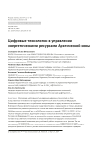Establishment and development of the institutions and management tools in the power industry and renewables in Russia
DOI: 10.33917/mic-6.119.2024.5-17
Todaу, a multi-level institutional structure has been established in the electric power industry in Russia. The analysis of the system of institutionalism in the Russian electric power industry and the identification of incentives for the development of renewable energy as a perspective area are important steps which help to understand the conditions for the development of renewable energy in Russia. The lack of a balanced and developed institutional environment can cause additional risks and instability in the energy industry, as well as hinder the investment attraction and new technologies in renewable energy.
References:
1. Auzan A.A. Institutional Economics: A New Institutional Economic Theory. M.: INFRA-M, 2011.
2. Acemoglu D., Robinson J. Why countries fail: the origin of power, prosperity and poverty. Moscow.: AST, 2012.
3. International Finance Corporation. IFC, 2023.
4. Wind power. Rosatom. URL: https://www.rosatom.ru/production/vetroenergetika/
5. Novak said that the Russian Federation will be able to replace equipment for renewable energy sources within 2–3 years. Interfax. URL: https://www.interfax.ru/russia/897800
6. Auzan A.A., Doroshenko M.E., Kalyagin V.G. Institutional economics. New institutional economic theory. M.: Prospect, 2023.
7. Urinson Y.M., Kozhukhovsky I. S., Sorokin I.S. Reforming the Russian electric power industry: results and unresolved issues. HSE Economic Journal. 2020;24(3)323–339.
8. Association «NP Market Council». URL: https://www.np-sr.ru/ru
9. Renewable Energy Development Association (ARVE). URL: https://rreda.ru/
10. The Future of Renewable Energy in Russia, XI Annual Conference. URL: https://events.vedomosti.ru/events/vie22
11. Veblen T. Theoria idle class. M.: Progress, 1984.
12. Electric vehicles. TAdviser. URL: https://www.tadviser.ru/index.php/Статья: Electric vehicles _ (global _ market)
13. Nekrasova I.E., Krivorot D.V., Stepanenko R.M. Social and legal institutionalism of John Commons. Scientific news, 2022.













